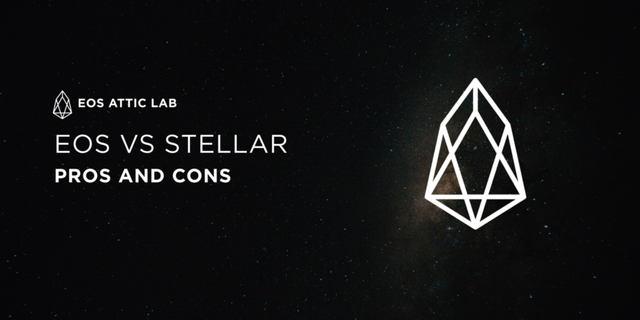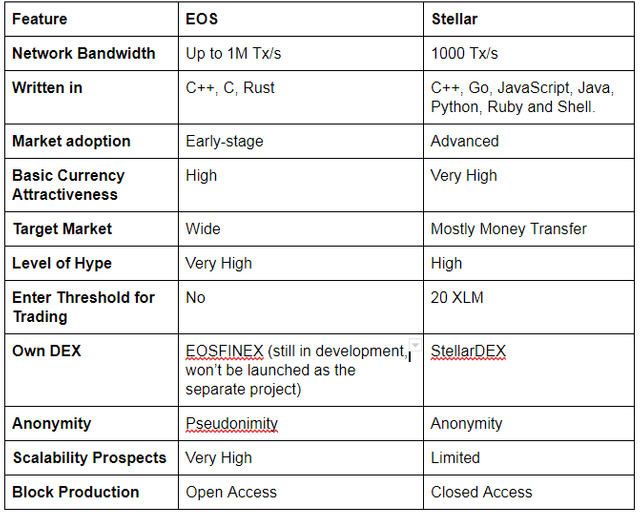
Abstract
During the turbulent history of blockchain, ICOs and cryptocurrencies development, there was always a project supposed to be ‘number one’ by the community. In 2009, it was Bitcoin as the first mass-adopted blockchain computation solution ever. In 2013 Vitalik Buterin suggested the Ethereum platform as the first dApps-building platform. Launched in 2015, it appeared tremendously amazing due to highest bandwidth and unsurpassed scalability prospects. Even today Ethereum based ERC-20 remains ‘Gold Standard’ for 4 of 5 new tokens. By the way, we are witnessing two projects each of which will highly likely replace Ethereum as the most high-productive and scalable dApps-hosting and data transfer blockchains - EOS and Stellar.
EOS: Ethereum-killer?
EOS (in fact, EOS.IO is a correct name for the blockchain while EOS is its basic cryptocurrency, but these two definitions often get confused with each other) acts as a decentralized operating system. The holders of EOS can use the shared GPU/CPU capacities, RAM volume, space for data storage etc. The core of EOS system is written in C, C++ and Rust which adds to its scalability and ‘developability’ in comparison with Solidity. EOS.IO whitepaper was released in 2017 by Block.One’s CTO Dan Larimer, ideologist of Graphene technology and two game changing products based on it - Bitshares decentralized crypto exchange (2014) and SteemIt social media platform (2016). EOS.IO conducted the ICO in unique way - they sold tokens on Ethereum platform, collected record amount of $4B in 349 days and then transferred all the tokens on native blockchain with its launch in June, 2018. EOS.IO works on delegated-proof-of-stake consensus as EOS holders make the decisions on block production and product further development.
Stellar: Hard Fork, Hard Work
Stellar as an open-source decentralized protocol allowing to transfer digital currency and exchange it into fiat money was initially launched as the hard-fork of Ripple protocol. In 2014 one of the Ripple co-founders Jed McCaleb criticized the administration of network for the excessive centralization and all-embracing commercial approach to product. He launched non-profit Stellar Development Foundation as the only authority for new project. The Stellar basic cryptocurrency, Stellar Lumens (XLM) has the limited supply - there can be only 100B XLM. According to the project documents, the main aim of the Stellar Foundation is to distribute XLM in fair manner, that’s the purpose of organized inflation (1 per cent every year) and limit for big XLM remittances. In 2014-2015 Stellar had worked on the Ripple protocol but after the security audit it was re-launched on the brand-new SCP protocol written in C++, Go, JavaScript, Java, Python, Ruby and Shell. Stellar is the most widely implemented crypto protocol worldwide: it is already used by American Express, IBM, Deloitte, KlikEx etc. as the technical framework for the real time remittances and data transfer.
Pros and Cons
EOS.IO ecosystem is higly appreciated by the community. The brilliant level of decentralization, the immaculate dApps-building potential due to simple coding solution, high operational bandwidth, outstanding team are usually named among its main positive sides. EOS was criticized during its ICO for the ‘grab-the-cash’ ambitions of its launchers, but after successful release of native blockchain in June, 2018 the haters’ voices were silenced. The situation with Stellar seems to be the same. Real decentralization, non-profit rhetorics of team, wide commercial implementation in real-world business, high long-term investments attractiveness of XLM - that’s rather elegant package for Stellar. By the way, we shouldn’t forget about the nature of the product struggling with the Ripple in savage rivalry from the very beginning. Ripple is much more stable, Ripple has bigger community and there’s a lot of arguments, which of two should be considered a fork.
One-on-one: EOS vs Stellar

So, the one can decide, which blockchain has the best prospects. It can be EOS with unlimited scalability perspectives and fair mechanism of block production or Stellar which has the widest real-world implementation.
If the article was interesting or useful (or both), please, subscribe on our socials!
Follow us!
Website: https://atticlab.net/eos/
Twitter: https://twitter.com/atticlab_it
Facebook: https://www.facebook.com/atticlab/
Reddit: https://www.reddit.com/r/atticlabeosb/
Steemit: https://steemit.com/eos/@attic-lab
Medium: https://medium.com/eosatticlab
Golos: https://golos.io/@atticlab
Telegram Chat: https://t.me/atticlabeosb
Telegram channel: https://t.me/eos_atticlab
WARNING - The message you received from @mirzaaliimran is a CONFIRMED SCAM!
DO NOT FOLLOW any instruction and DO NOT CLICK on any link in the comment!
For more information, read this post:
https://steemit.com/steemit/@arcange/phishing-site-reported-steembottracker-steemrew-dot-ga
If you find my work to protect you and the community valuable, please consider to upvote this warning or to vote for my witness.
Downvoting a post can decrease pending rewards and make it less visible. Common reasons:
Submit
WARNING - The message you received from @mirzaaliimran is a CONFIRMED SCAM!
DO NOT FOLLOW any instruction and DO NOT CLICK on any link in the comment!
For more information about this scam, read this post:
https://steemit.com/steemit/@arcange/phishing-site-reported-steembottracker-steemrew-dot-ga
If you find my work to protect you and the community valuable, please consider to upvote this warning or to vote for my witness.
Downvoting a post can decrease pending rewards and make it less visible. Common reasons:
Submit
Coins mentioned in post:
Downvoting a post can decrease pending rewards and make it less visible. Common reasons:
Submit